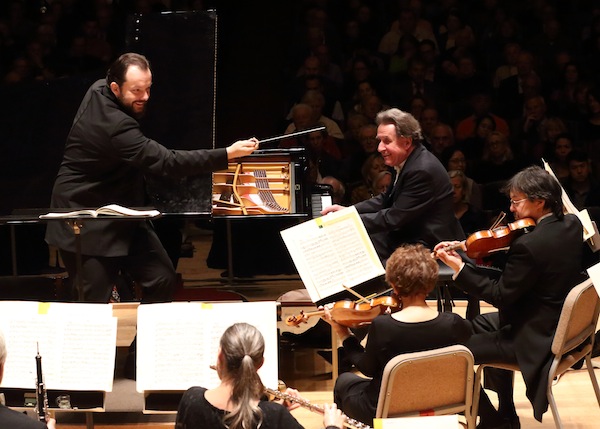Nelsons, BSO continue Bruckner journey with a resounding Fourth

Rudolf Buchbinder performed Beethoven’s Piano Concerto No. 1 with Andris Nelsons and the Boston Symphony Orchestra Tuesday night. Photo: Hilary Scott
When Andris Nelsons came to Boston four years ago, he brought with him a plan to lead the Boston Symphony Orchestra in performances of symphonies by Shostakovich and Bruckner, music eschewed by previous music director James Levine. To date, Nelsons’ Shostakovich project has resulted in award-winning recordings, and his equally successful Bruckner survey is well under way.
Nelsons has led the Third, Sixth, and Seventh Symphonies in the past three seasons. Tuesday night at Symphony Hall he continued with the composer’s popular Symphony No. 4.
Bruckner was a lifelong devotee of Wagner, a choice that resulted in harsh criticisms of his music in Viennese circles. But Bruckner persisted and the Fourth Symphony owes something to Wagner’s style. Phrases build in intensity over long stretches, and the orchestration has a sense of both primordial darkness and radiant light.
But the Fourth also casts an eye to the past. The work’s subtitle—”Romantic”—reflects the nature mysticism of early 19th-century German literature, and Nelsons’ reading mined the lush, song-filled reverie from the score.
As is often the case with Nelsons’ performances of large-scale works, details were aplenty. The horn calls that opened the piece seemed to sound out from a distance, and the first movement’s lyrical second theme flowered beautifully.
There was a firm sense of direction as well. A characteristically Brucknerian rhythm—a duplet figure followed by a triplet—permeates this symphony, and the musical germ culminated in earth-shaking tuttis that rang in the hall. In lyrical passages the orchestra sounded with enveloping warmth and crescendos seemed to sound from the bottom up.
In the second movement, the conductor found a chamber-like intimacy in the sparse textures. The opening cello melody glowed with a touch of sweet sorrow before the theme resurfaced in an amber-toned viola line, and, later, a sunlit passage in the violins. A few unfortunate cracks marred the muted horn call, but elsewhere the wind solos had a supple quality that would be equally at home in Mahler’s music.
Bruckner hunting-horn scherzo was a late addition to this symphony, and Nelsons drew playing of crackling energy from the brass in the galloping theme. Nelsons shaped the Ländler Trio in flowing arcs, and the music took on a gentle Viennese lilt.
Bruckner’s symphony also has an organic unity, and the horn call that opens the work returns in the finale in an inverted form. Nelsons coaxed playing of world-weary resonance from the line before unfolding the ensuing climax into passages of visceral power and depth. The second theme, heard in the rosy-toned strings, brought a touch of sunshine.
But the movement, which changes moods on a dime, quickly returned to darkness, and Nelsons, in the process, led with a careful eye to every nuance of phrasing. The coda, which the conductor drew out with generous rubato shading, concluded the work with a sense of resounding mystery.
The opener, Beethoven’s Piano Concerto No. 1 with soloist Rudolf Buchbinder, was surprisingly mixed.
Despite his celebrated performances and recordings of Beethoven’s music, Buchbinder has only performed with the BSO twice: once in 1986 with Beethoven’s Third Piano Concerto, and recently in 2014 with Brahms’ First Piano Concerto. He will make his belated Tanglewood debut this summer in performances with the orchestra and Boston Symphony Chamber Players.
Given his performance Tuesday night, it is understandable why Buchbinder is not a regular guest in Boston. His playing is clear, but not always convincing, and his Apollonian performance resulted in little drama.
His keyboard touch, though, brought out the work’s Mozartean intimacy. Trickling lines in the outer movements had a soft elegance. Buchbinder used a slight pedal, and each note rang with a distinct ping.
There were also some beautiful moments. In the second movement, the pianist drew out the lyrical theme with poetic touch. And even though Nelsons made little of the movement’s chamber-like passages, a soft solo from William R. Hudgins’ clarinet wrapped the pianist in a blanket of sound.
But the orchestra surely supplied the drama. Where Buchbinder’s playing was graceful and detached, Nelsons’ rendition of the accompaniment had momentum and plush warmth. In short, this was a performance that fell between two stools.
The program will repeat 1:30 p.m. Friday and 8 p.m. Saturday at Symphony Hall. bso.org; 888-266-1200
Posted in Performances